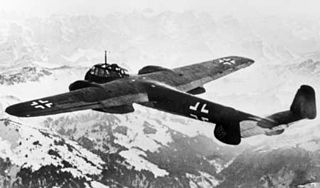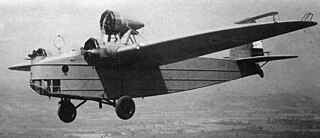
The Dornier Do 17 is a twin-engined light bomber designed and produced by the German aircraft manufacturer Dornier Flugzeugwerke. Large numbers were operated by the Luftwaffe throughout the Second World War.

The Dornier Do 215 was a light bomber, aerial reconnaissance aircraft and later a night fighter, produced by Dornier originally for export, but in the event most served in the Luftwaffe. Like its predecessor, the Dornier Do 17, it inherited the title "The Flying Pencil" because of its slim fuselage. The successor of the Do 215 was the Do 217.

The Göppingen Gö 9 was a German experimental aircraft built to investigate the practicalities of powering a plane using a pusher propeller located far from the engine and turned by a long driveshaft.

The Dornier Do 11 was a German heavy bomber, developed in secret in the early 1930s. It was originally called the Dornier F before being renamed by the Reichsluftfahrtministerium (RLM) in 1933, and was considered a heavy bomber at the time. It came into service in 1932, a continuation of a line of bomber designs from the Dornier Do P in 1930, and the Dornier Do Y in 1931. The line would continue to develop with the Dornier Do 13 and Dornier Do 23.

The Dornier Do 12 Libelle III was the third of a line of small German flying boats of the 1930s. It started with the Dornier A Libelle I and the Dornier A Libelle II, though the Do 12 was not a continuation, but an entirely new aircraft.

The Dornier Do 23 was a German medium bomber of the 1930s.

The Dornier Do 18 was a development of the Do 16 flying boat. It was developed for the Luftwaffe, but Deutsche Luft Hansa received five aircraft and used these for tests between the Azores and the North American continent in 1936 and on their mail route over the South Atlantic from 1937 to 1939.
The Junkers Ju 187 was a German projected dive bomber designed to replace the ageing Junkers Ju 87 Stuka. The Ju 187 was cancelled in 1943.

The Dornier Do 22 was a German seaplane, developed in the 1930s. Despite good performance, it was built only in small numbers and entirely for the export market. The type was operated in the Second World War by Finland, Greece and Yugoslavia.

The Dornier Do 27 is a German single-engine STOL utility aircraft that was designed and manufactured by Dornier GmbH. It was notable for being the first mass-produced aircraft in Germany following the end of the Second World War.

The Dornier Do 317 was a prototype German medium bomber of World War II.

The Dornier Do 214 was a proposed large long-range flying boat, developed by Dornier in World War II.

The Albatros Al 101 was a 1930s German trainer aircraft. It was a parasol-wing monoplane of conventional configuration, and seated the pilot and instructor in separate, open cockpits.

After the success of the 1940 airborne assaults involving the DFS 230, the Reichsluftfahrtministerium invited the Deutsche Forschungsanstalt für Segelflug/DFS and Gotha to submit plans for a larger capacity glider. The result was the DFS 231, a twenty-seat troop designed by Hans Jacobs, who had previously produced the successful, nine seat DFS 230.

The Dornier Do Y was a trimotor German monoplane bomber of the early 1930s designed by Dornier Flugzeugwerke to an order by the Royal Yugoslav Air Force (RYAF). The Yugoslavs originally intended to use war reparations to pay for them, but ultimately had to use their own funds. Only a pair of aircraft were initially ordered to give the Yugoslavs experience with multi-engine bombers and Dornier failed to sell any more Do Y's. Two improved versions were subsequently built on speculation, but failed to find purchasers until the RYAF bought them in 1935.

The Arado Ar 77 was a German twin-engined monoplane, designed as an advanced training aircraft from 1934.

The Albatros L102 / Albatros Al 102, was a German trainer aircraft of the 1930s. It was a parasol-wing landplane, seating the student pilot and instructor in separate, open cockpits. A biplane floatplane version was also built as the Al 102W, with strut-braced lower wings.
The Albatros L 103 / Albatros Al 103 was a German experimental aircraft of the 1930s. It was a parasol-wing landplane of conventional configuration, seating the pilot and flight test observer in separate, open cockpits. The Al 103 was used to test variations in sweepback, dihedral and tailplane area.

The Zeppelin-Lindau Rs.IV was a Riesenflugzeug monoplane all metal flying boat with a stressed skin hull and fuselage developed for the Imperial German Navy to perform long range patrols over the North Sea. It had been developed by Claudius Dornier while working for Zeppelin in the town of Lindau.
The Dornier Do 417 was a twin-engine multirole combat aircraft. Developed in 1942, it resulted from the Luftwaffe's request for a medium bomber, a contest in which Dornier, Junkers, Heinkel, and Blohm & Voss competed. In the end, the Junkers Ju 188 was chosen by the Luftwaffe, and the Do 417 never entered production.

















